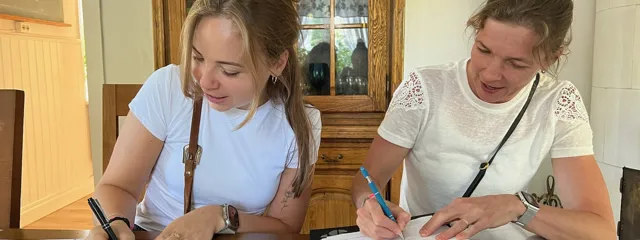In Vara, students have dramatic art on the school schedule

The curriculum states that students must be given the opportunity to learn about, and from, the performing arts. We do this through school performances at Vara Concert Hall, a way for more children and young people to enjoy laughter and butterflies in their stomachs!
Children should be able to enjoy various cultural expressions such as dance, musicals, circus, plays and concerts with classical music, world music and folk music
Every year, a number of school performances are staged at Vara Concert Hall. All of Vara’s pupils up to and including high school get to see two performances per school year. In addition to the performances for schools, at least six family Saturday evenings for all ages are organized every year.
“It’s important to take children’s audiences seriously. You can’t fool children and they react directly to what they see,” says Helena Helén, producer for children and young people and in charge of school performances and family evenings at Vara Concert Hall.
Why are performing arts important in school?
“Children should be able to enjoy various cultural expressions such as dance, musicals, circus, plays and concerts with classical music, world music and folk music. For some children and young people, school performances are the only contact with performing arts live, so breadth is very important.” Helena thinks having children in the audience is always special.
“A good performance demands lots of actors. Children show clearly what they think, sometimes even during the show. They’re often an involved public with a lot of emotions. If you want to reach a children’s audience, the genre isn’t that important, but it has to be genuine and honest to really grab them,” says Helena.
Vara Concert Hall also offers performances for older students and collaborates with high schools with arts courses.
“We collaborate with the Swedish National Ballet School in Gothenburg and several dance courses. We also invite dance students from high school arts courses to meet the dancers in our professional performances. It gets them closer than just being an audience member.”

Curious about Skaraborg? Subscribe to our newsletter!
Our newsletter is filled with information about people in Skaraborg. Here, you can find tips on major employers, upcoming events, and more.
Newsletter
What do you do to reach all the children and young people?
“Only reaching out to your usual audience is making life easy for yourself, but we want the people we haven’t reached yet! We also want to spread culture to children suffering exclusion and collaborate with the social services to distribute tickets. We also collaborate with Conventus, which is in contact with new families in Sweden. They’ve also been given tickets for our family Saturdays. It’s rewarding to work with a manager who’s passionate about children and youth culture and prioritizes inclusion and diversity.”
The manager Helena mentions is Petra Kloo, Vara Concert Hall’s CEO, who was previously a children’s violin teacher, and a producer and in charge of Gothenburg Symphony Orchestra’s children and youth activities.
“Society is so polarized today, we’re afraid of everything different. It’s so important for us to succeed in reflecting the diversity of society in what we perform on stage, for young and adult audiences alike,” says Petra Kloo.
There are materials for many of the performances that the teachers can work with before or after the show.
What can young people learn from the performing arts?
“Curiosity! The performing arts should move us and stimulate an urge to explore. Regardless of the feelings we awaken in children, we want them to learn how to put their experiences into words and discuss them. If they come back here as young adults, then we’ve really reached them,” concludes Helena.





